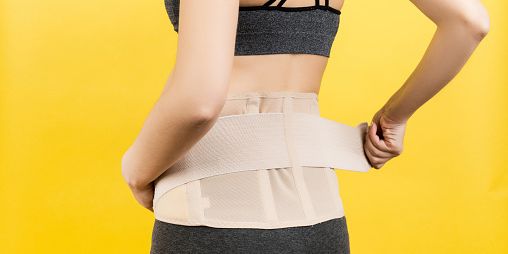If you aren’t given a belly band in the hospital, follow the manufacturer’s instructions when putting one on for the first time, and ask your ob-gyn or physical therapist for a tutorial if you’re unsure. Or, if you’re interested in Bengkung belly binding, you may be able to find a doula near you that offers this as part of their services.
Look out for any red-flag symptoms.
It might feel a little weird when you first fasten on a belly band, but it definitely shouldn’t be painful. Take it off if you experience discomfort (especially around your C-section incision), difficulty breathing, or any kind of pelvic pressure.
This last one is really important, because there’s some concern that tightly fitting belly bands could put too much stress on your pelvic floor, which might theoretically worsen a case of pelvic organ prolapse. This condition, when any of the pelvic organs such as the vagina, uterus, or bladder drop down, can sometimes occur after childbirth—if you have any signs, like pelvic pain, pressure, or a visible bulge from your vagina, reach out to your ob-gyn right away.
Also: Some belly bands contain latex, so check the label and choose one that’s latex-free if you have an allergy.
Keep it clean.
Like everything else you have on in those early postpartum days, belly bands can get surprisingly dirty, especially if you’re wearing one over your C-section incision or while feeding your baby—so do your best to wash it regularly, and maybe even have a backup so you can rotate them.
“A lot of patients don’t want to wear a binder because it gets too messy while breastfeeding,” Dr. Cobb says. “It’s another layer of clothing to keep clean. So having more than one, ideally from the hospital, is what I usually recommend.”
Continue those deep core exercises.
Research suggests deep core exercises—workouts that target core muscles like the transverse abdominis, multifidus, and pelvic floor—support your postpartum core recovery and may help improve diastasis recti. Gently activating these muscles rebuilds your foundational core strength after giving birth, Dr. Weber says, and this can be as simple as paying attention to your breath.
“You should be thinking about your deep breathing,” she says, “allowing your ribcage and your abdominal wall to expand as you inhale, and connecting to those core muscles on the exhale.” If your belly band prevents you from taking these big, deep breaths, give yourself a little break.
Phase it out after a few weeks.
Supporting your core, easing pain, encouraging you to sit up a little straighter—all of these benefits can make wearing a postpartum belly band feel really nice. But you should “think about it as a short-term tool,” says Dr. Weber.
Leading expert groups like ACOG don’t give specific guidelines on when to stop using a postpartum belly band, but the experts we spoke to recommend cutting back as soon as you feel comfortable going without it—this could be as soon as a few days, if you’re feeling good, and ideally within a month or so.
“After six to eight weeks, it’s probably not something to rely on for daily use,” says Dr. Cobb. “If you’re still having problems and feeling like you have to wear one, it’s time to see a physical therapist.”
Get more of SELF’s great service journalism delivered right to your inbox.
Read the full article here



